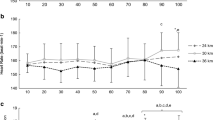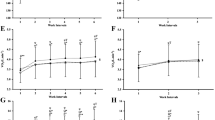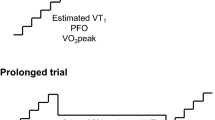Abstract
Purpose
Previous research has suggested that the optimal pacing strategy for self-paced exercise lasting >4 min is a uniform distribution of work, but this posit is not well established for prolonged endurance events. This study examined the utility of even pacing during 20 km cycling time trials (TTs).
Methods
Fifteen well-trained male cyclists (\(\dot{V}\)O2max = 4.80 ± 0.38 L min−1) completed three best effort self-paced (SP) simulated 20 km TTs, followed by two even-paced trials. In one even-paced trial, participants cycled to exhaustion (EPtlim) at a fixed intensity equivalent to their best SP performance. In the other EP trial, participants were instructed to maintain this target intensity for a distance of 20 km, but the actual intensity was free to vary depending on the effort and cadence of the cyclist (EP-maintained). Cardiorespiratory, blood lactate and perceptual (RPE and affect) measures were assessed throughout.
Results
Nine out of fifteen cyclists failed the EPtlim task, completing 51–83 % (10.3–15.3 km) of the work done in their SP trial. Failure as a result of even pacing was associated with a faster rise in blood lactate, attainment of a higher relative intensity during SP and a moderate fast starting strategy. This failure was independent of the nature of the even-paced task.
Conclusion
By adopting an uneven, parabolic distribution of work, cyclists in this study were able to achieve an average intensity during self-paced exercise in excess of their maximum sustainable power output. A subsequent matched even-paced bout resulted in cumulative metabolic stress that could not be managed by moment-to-moment changes in power output. These results challenge the notion that strict even pacing is optimal for endurance time trial events.






Similar content being viewed by others
References
Abbiss CR, Ross ML, Garvican LA, Ross N, Pottgiesser T, Gregory J, Martin DT (2013) The distribution of pace adopted by cyclists during a cross-country mountain bike world championships. J Sports Sci 31(7):787–794. doi:10.1080/02640414.2012.751118
Amann M, Proctor LT, Sebranek JJ, Pegelow DF, Dempsey JA (2009) Opioid-mediated muscle afferents inhibit central motor drive and limit peripheral muscle fatigue development in humans. J Physiol 587(Pt 1):271–283. doi:10.1113/jphysiol.2008.163303
Atkinson G, Davison R, Jeukendrup A, Passfield L (2003) Science and cycling: current knowledge and future directions for research. J Sports Sci 21(9):767–787
Atkinson G, Peacock O, Passfield L (2007a) Variable versus constant power strategies during cycling time-trials: Prediction of time savings using an up-to-date mathematical model. J Sports Sci 25(9):1001–1009
Atkinson G, Peacock O, St Clair Gibson A, Tucker R (2007b) Distribution of power output during cycling: Impact and mechanisms. Sports Med 37(8):647–667
Billat VL, Wesfreid E, Kapfer C, Koralsztein JP, Meyer Y (2006) Nonlinear dynamics of heart rate and oxygen uptake in exhaustive 10,000 m runs: Influence of constant vs. Freely paced. J Physiol Sci 56(1):103–111. doi:physiolsci/R2028
Borg GA (1982) Psychophysical bases of perceived exertion. Med Sci Sports Exerc 14(5):377–381
Burnley M, Vanhatalo A, Jones AM (2012) Distinct profiles of neuromuscular fatigue during muscle contractions below and above the critical torque in humans. J Appl Physiol 113(2):215–223. doi:10.1152/japplphysiol.0.0022.2012
Corbett J (2009) An analysis of the pacing strategies adopted by elite athletes during track cycling. Int J Sports Physiol Perform 4(2):195–205
de Koning JJ, Foster C, Bakkum A, Kloppenburg S, Thiel C, Joseph T, Cohen J, Porcari JP (2011) Regulation of pacing strategy during athletic competition. PLoS ONE 6(1):e15863. doi:10.1371/journal.pone.0015863
Decorte N, Lafaix PA, Millet GY, Wuyam B, Verges S (2012) Central and peripheral fatigue kinetics during exhaustive constant-load cycling. Scand J Med Sci Sports 22(3):381–391. doi:10.1111/j.1600-0838.2010.01167.x
Duc S, Betik A-C, Grappe F (2004) Emg activity does not change during a time trial in competitive cyclists. Int J Sports Med 26(02):145–150
Foster C, Snyder AC, Thompson NN, Green MA, Foley M, Schrager M (1993) Effect of pacing strategy on cycle time trial performance. Med Sci Sports Exerc 25(3):383–388
Foster C, Schrager M, Snyder AC, Thompson NN (1994) Pacing strategy and athletic performance. Sports Med 17(2):77–85
Froyd C, Millet GY, Noakes TD (2013) The development of peripheral fatigue and short-term recovery during self-paced high-intensity exercise. J Physiol 591(5):1339–1346. doi:10.1113/jphysiol.2012.245316
Fukuba Y, Whipp BJ (1999) A metabolic limit on the ability to make up for lost time in endurance events. J Appl Physiol 87(2):853–861
Gordon S (2005) Optimising distribution of power during a cycling time trial. Sports Eng 8(2):81–90
Gosztyla AE, Edwards DG, Quinn TJ, Kenefick RW (2006) The impact of different pacing strategies on five-kilometer running time trial performance. J Strength Cond Res 20(4):882–886. doi:10.1519/R-19275.1
Green JM, Sapp AL, Pritchett RC, Bishop PA (2010) Pacing accuracy in collegiate and recreational runners. Eur J Appl Physiol 108(3):567–572. doi:10.1007/s00421-009-1257-5
Ham DJ, Knez WL (2009) An evaluation of 30-km cycling time trial (tt30) pacing strategy through time-to-exhaustion at average tt30 pace. J Strength Cond Res 23(3):1016–1021. doi:10.1519/JSC.0b013e3181a30f8f
Hopkins WG (2000) Measures of reliability in sports medicine and science. Sports Med 30(1):1–15
Hull JH, Ansley P, Ansley L (2008) Human tissue act: Implications for sports science. Br J Sports Med 42(4):236–237. doi:10.1136/bjsm.2007.043307
Jones AM (2007) Middle- and long- distance running. In: Winter EM, Jones AM, Davison RC, Bromley PD, Mercer TH (eds) Bases sport and exercise physiology testing guidelines, vol 1., sport testingRoutledge, New York, pp 147–154
Jones AM, Wilkerson DP, DiMenna F, Fulford J, Poole DC (2008) Muscle metabolic responses to exercise above and below the “critical power” assessed using 31p-mrs. Am J Physiol Regul Integr Comp Physiol 294(2):R585–R593. doi:10.1152/ajpregu.0.0731.2007
Kennedy MD, Bell GJ (2003) Development of race profiles for the performance of a simulated 2000-m rowing race. Can J Appl Physiol 28(4):536–546
Lander PJ, Butterly RJ, Edwards AM (2009) Self-paced exercise is less physically challenging than enforced constant pace exercise of the same intensity: Influence of complex central metabolic control. Br J Sports Med 43(10):789–795. doi:10.1136/bjsm.2008.056085
Marcora SM, Staiano W, Manning V (2009) Mental fatigue impairs physical performance in humans. J Appl Physiol 106(3):857–864. doi:10.1152/japplphysiol.9.1324.2008
Mattern CO, Kenefick RW, Kertzer R, Quinn TJ (2001) Impact of starting strategy on cycling performance. Int J Sports Med 22(5):350–355. doi:10.1055/s-2001-15644
Mauger AR, Neuloh J, Castle PC (2012) Analysis of pacing strategy selection in elite 400-m freestyle swimming. Med Sci Sports Exerc 44(11):2205–2212. doi:10.1249/MSS.0b013e3182604b84
Muehlbauer T, Melges T (2011) Pacing patterns in competitive rowing adopted in different race categories. J Strength Cond Res 25(5):1293–1298. doi:10.1519/JSC.0b013e3181d6882b
Newell J, Aitchison T, Grant S (2010) Statistics for sports and exercise science: a practical approach. Pearson Education, Harlow
Padilla S, Mujika I, Angulo F, Goiriena JJ (2000a) Scientific approach to the 1-h cycling world record: A case study. J Appl Physiol 89(4):1522–1527
Padilla S, Mujika I, Orbananos J, Angulo F (2000b) Exercise intensity during competition time trials in professional road cycling. Med Sci Sports Exerc 32(4):850–856
Palmer GS, Hawley JA, Dennis SC, Noakes TD (1994) Heart rate responses during a 4-d cycle stage race. Med Sci Sports Exerc 26(10):1278–1283
Rejeski WJ (1985) Perceived exertion: an active or passive process? J Sport Psychol 7(4):371–378
Robergs RA, Dwyer D, Astorino T (2010) Recommendations for improved data processing from expired gas analysis indirect calorimetry. Sports Med 40(2):95–111. doi:10.2165/11319670-000000000-00000
Saunders MJ, Evans EM, Arngrimsson SA, Allison JD, Warren GL, Cureton KJ (2000) Muscle activation and the slow component rise in oxygen uptake during cycling. Med Sci Sports Exerc 32(12):2040–2045
Shinohara M, Moritani T (1992) Increase in neuromuscular activity and oxygen uptake during heavy exercise. Ann Physiol Anthrop 11(3):257–262
Stone MR, Thomas K, Wilkinson M, Jones AM, St Clair Gibson A, Thompson KG (2012) Effects of deception on exercise performance: Implications for determinants of fatigue in humans. Med Sci Sports Exerc 44(3):534–541. doi:10.1249/MSS.0b013e318232cf77
Thomas K, Stone MR, Thompson KG, St Clair Gibson A, Ansley L (2012a) The effect of self- even- and variable-pacing strategies on the physiological and perceptual response to cycling. Eur J Appl Physiol 112(8):3069–3078. doi:10.1007/s00421-011-2281-9
Thomas K, Stone MR, Thompson KG, St Clair Gibson A, Ansley L (2012b) Reproducibility of pacing strategy during simulated 20-km cycling time trials in well-trained cyclists. Eur J Appl Physiol 112(1):223–229. doi:10.1007/s00421-011-1974-4
Thompson KG, MacLaren DP, Lees A, Atkinson G (2003) The effect of even, positive and negative pacing on metabolic, kinematic and temporal variables during breaststroke swimming. Eur J Appl Physiol 88(4–5):438–443. doi:10.1007/s00421-002-0715-0
Tucker R, Bester A, Lambert EV, Noakes TD, Vaughan CL, St Clair Gibson A (2006a) Non-random fluctuations in power output during self-paced exercise. Br J Sports Med 40(11):912–917
Tucker R, Lambert MI, Noakes TD (2006b) An analysis of pacing strategies during men’s world-record performances in track athletics. Int J Sports Physiol Perform 1(3):233–245
Vanhatalo A, Jones AM, Burnley M (2011) Application of critical power in sport. Int J Sports Physiol Perform 6(1):128–136
Wilberg RB, Pratt J (1988) A survey of the race profiles of cyclists in the pursuit and kilo track events. Can J Sport Sci 13(4):208–213
WMA (2008) World medical association declaration of helsinki. Ethical principles for medical research involving human subjects. http://www.wma.net/en/30publications/10policies/b3/17c.pdf
Acknowledgments
Funding for this research was provided by the Research and Development Fund, Northumbria University.
Conflict of interest
The authors declare that they have no conflict of interest.
Author information
Authors and Affiliations
Corresponding author
Additional information
Communicated by Peter Krustrup.
Rights and permissions
About this article
Cite this article
Thomas, K., Stone, M., St Clair Gibson, A. et al. The effect of an even-pacing strategy on exercise tolerance in well-trained cyclists. Eur J Appl Physiol 113, 3001–3010 (2013). https://doi.org/10.1007/s00421-013-2734-4
Received:
Accepted:
Published:
Issue Date:
DOI: https://doi.org/10.1007/s00421-013-2734-4




